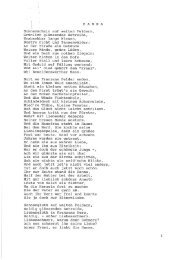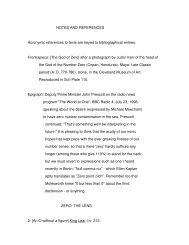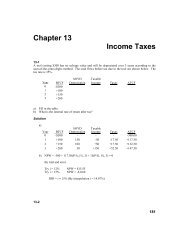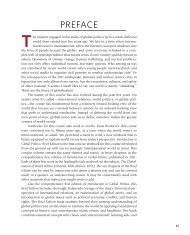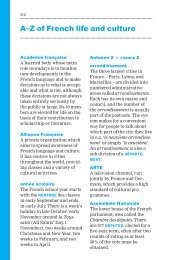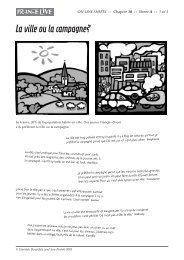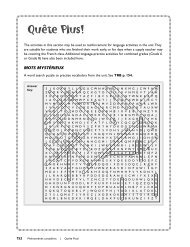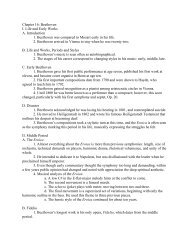CHAPTER 3 Consumer Preferences and Choice
CHAPTER 3 Consumer Preferences and Choice
CHAPTER 3 Consumer Preferences and Choice
You also want an ePaper? Increase the reach of your titles
YUMPU automatically turns print PDFs into web optimized ePapers that Google loves.
03-Salvatore-Chap03.qxd 08-08-2008 12:41 PM Page 83<br />
SUMMARY<br />
<strong>CHAPTER</strong> 3 <strong>Consumer</strong> <strong>Preferences</strong> <strong>and</strong> <strong>Choice</strong> 83<br />
to A at the higher PX/PY given by S ′ S ′ . It follows that the indifference curve on which<br />
A falls must lie below points G <strong>and</strong> J. The process can be repeated any number of<br />
times to further reduce the upper <strong>and</strong> lower zones of ignorance, thereby locating the<br />
indifference curve more precisely. Note that the indifference curve derived is the one<br />
we need to show consumer equilibrium because it is the indifference curve that is tangent<br />
to the consumer’s budget line.<br />
Although somewhat impractical as a method for actually deriving indifference<br />
curves, the theory of revealed preference (particularly the idea that a consumer’s<br />
tastes can be inferred or revealed by observing actual choices in the market place) has<br />
been very useful in many applied fields of economics such as public finance <strong>and</strong><br />
international economics. The appendix to Chapter 4 applies the theory of revealed<br />
preference to measure changes in st<strong>and</strong>ards of living <strong>and</strong> consumer welfare during<br />
inflationary periods.<br />
1. The want-satisfying quality of a good is called utility. More units of a good increase total<br />
utility (TU) but the extra or marginal utility (MU) declines. The saturation point is reached<br />
when TU is maximum <strong>and</strong> MU is zero. Afterwards, TU declines <strong>and</strong> MU is negative. The<br />
decline in MU is known as the law of diminishing marginal utility. Cardinal utility actually<br />
provides an index of satisfaction for a consumer, whereas ordinal utility only ranks various<br />
consumption bundles.<br />
2. The tastes of a consumer can be represented by indifference curves. These are based on<br />
the assumptions that the consumer can rank baskets of goods according to individual<br />
preferences, tastes are consistent <strong>and</strong> transitive, <strong>and</strong> the consumer prefers more of a good to less.<br />
An indifference curve shows the various combinations of two goods that give the consumer<br />
equal satisfaction. Higher indifference curves refer to more satisfaction <strong>and</strong> lower indifference<br />
curves to less. Indifference curves are negatively sloped, cannot intersect, <strong>and</strong> are convex to the<br />
origin. The marginal rate of substitution (MRS) measures how much of a good the consumer is<br />
willing to give up for one additional unit of the other good <strong>and</strong> remain on the same indifference<br />
curve. Indifference curves also generally exhibit diminishing MRS.<br />
3. A rapid convergence of tastes is taking place in the world today. Tastes in the United States<br />
affect tastes around the world, <strong>and</strong> tastes abroad strongly influence tastes in the United States.<br />
With the tremendous improvement in telecommunications, transportation, <strong>and</strong> travel, the<br />
convergence of tastes can only be expected to accelerate—with important implications for us as<br />
consumers, for firms as producers, <strong>and</strong> for the study of microeconomics.<br />
4. The budget line shows the various combinations of two goods (say, X <strong>and</strong> Y) that a consumer can<br />
purchase by spending all income (I) on the two goods at the given prices (PX <strong>and</strong> PY). The vertical<br />
or Y-intercept of the budget line is given by I/PY <strong>and</strong> −PX/PY is the slope. The budget line shifts up<br />
if I increases <strong>and</strong> down if I decreases, but the slope remains unchanged. The budget line rotates<br />
upward if PX falls <strong>and</strong> downward if PX rises.<br />
5. A rational consumer maximizes utility when reaching the highest indifference curve possible<br />
with the budget line. This occurs where an indifference curve is tangent to the budget line so<br />
that their slopes are equal (i.e., MRSXY = PX/PY). Government warnings or new information<br />
may change the shape <strong>and</strong> location of a consumer’s indifference curves <strong>and</strong> the consumption<br />
pattern. If indifference curves are everywhere either flatter or steeper than the budget line or



